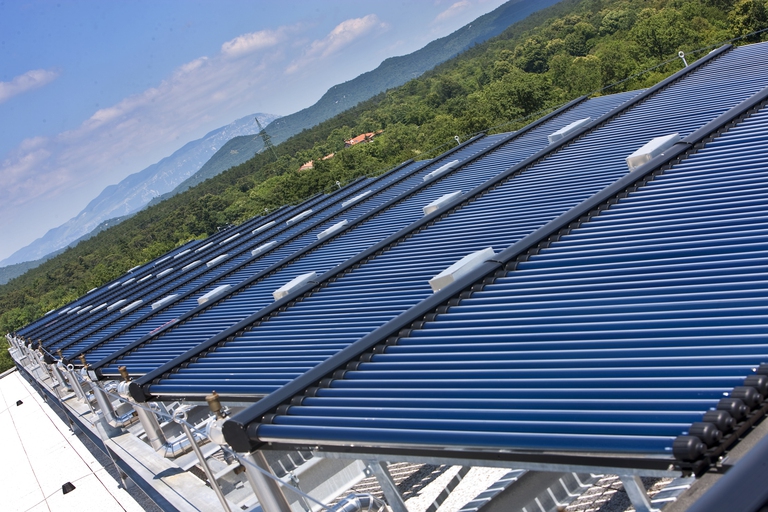
Dodicimila piastrelle colorate per la facciata solare del Copenhagen International School che producono il 50 per cento dell’energia necessaria
Si chiama solar cooling ed è una tecnologia che sfrutta l’energia solare per produrre aria fredda. A Trieste un progetto pilota raffresca il Science Park.
Adriacold project, a pilot plant built within Trieste’s Science Park and producing cold air using solar energy , aims to reduce cooling costs and consumption, produce cold air using renewable energy and cut climate-changing emissions.
Combining room cooling with the production of domestic hot water, solar cooling technology is being tested throughout Europe and exploits solar thermal energy to produce heat in winter and cool air in summer. That is the reason why the University of Trieste and Cortea scrl intend to build an accessory pilot plant located near the cafeteria building of Basovizza Campus, within AREA Science Park. The Cafeteria supplies about 250 meals every day in wide rooms and, during summer, building cooling alone costs 10,000 euros. “Solar cooling is an eco-friendly technology allowing cutting managing costs,” explained Marcello Guaiana, Adriacold project manager.
Adriacold built 6 cooling plants in Italy, Slovenia and Croatia, in places such as schools, hotels, greenhouses and public administration buildings. “The European Union asks a collective effort in support of renewable energy and energy efficiency” explained Stefano Casaleggi, AREA Science Park general manager. “Adriacold project represents a public administration which plays an active role in testing and sometimes even developing new technologies before making them available to the general public. Such commitments strengthen our intention to continue the experimentation and spreading of innovative energy technologies and, more generally speaking, to support the creation, development and testing of type models in different technological domains.”
Consisting of wells, the “solar field” collects thermal energy. This energy is conveyed to a refrigeration system equipped with zeolite salts and lithium bromide which can cool water to about 7 ° C. Water is then conveyed to normal air conditioning systems.
[vimeo url=”https://vimeo.com/130205616″]
Freschi col sole from AREA Science Park on Vimeo.
The pilot plant allowed carrying out the feasibility test. According to the data collected, the costs of an almost 7850 BTU/h plant in Northern Italy, with a surface of 800 square metres, will be paid in about 7 years. “As far as technical specifications are concerned, it is economically convenient to install high and medium power solar cooling system (systems exceeding 3412 BTU) in Italy, also thanks to the Italian “thermal account” decree (aiming to subsidize thermal energy output from renewable sources), with an economic return ranging from 3 to 9 years” explains Marcello Guaiana. “This technology proved to be viable both technically and economically if it fully employs the thermal energy produced by the cooling system, which is used for heating during winter and for the production of domestic hot water, thus proving once again the key role of energy efficiency.”
Siamo anche su WhatsApp. Segui il canale ufficiale LifeGate per restare aggiornata, aggiornato sulle ultime notizie e sulle nostre attività.
![]()
Quest'opera è distribuita con Licenza Creative Commons Attribuzione - Non commerciale - Non opere derivate 4.0 Internazionale.
Dodicimila piastrelle colorate per la facciata solare del Copenhagen International School che producono il 50 per cento dell’energia necessaria
In cinque anni lo stato di New York ha registrato una crescita record per il solare con 1,5 miliardi di dollari di investimenti privati e 8mila posti di lavoro
For the first time ever a plane powered by solar energy has completed a round-the-world trip, flying 40,000 km without fuel. Watch the video of its last, triumphal landing.
A group of experts in Tokyo suggested pouring radioactive water from Fukushima into the open sea. A marine biochemist explains the consequences of this absurd decision.
A federal court in Washington, D.C. has struck down the Dakota Access Pipeline, following years of campaigning by the Standing Rock Sioux tribe.
The Scottish island of Eigg is self-sufficient for its energy needs, relying almost entirely on renewable sources, especially thanks to a coordinated community effort.
L’aereo solare ha attraversato il Pacifico ed ora è tornato in volo verso Phoenix. Online la diretta del volo si Solar Impulse 2.
2020, the year of the EU climate and energy package is round the corner. The climate package aims to reduce greenhouse gases emissions by 20%, improve energy efficiency by 20% and raise energy consumption from renewable sources to 20%. The average level of CO2 emissions of a new car must be limited to 95 grams and drivers
Retrofitting is a technical term which means modifying the technology of an object to improve its performances. Segun Oyeyiola, a Nigerian student of Engineering, just retrofitted an old Volkswagen Beetle and turned it into a solar and wind-powered car. Within a year the final year student managed to convert the Beetle into a









